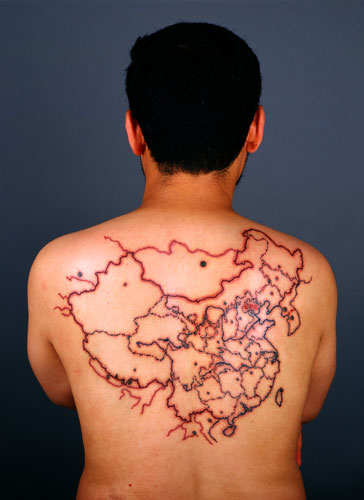Contemporary Chinese art displayed in old Vienna
china.org.cn / chinagate.cn by Harvey Dzodin, December 2, 2014 Adjust font size:
|
|
|
The Miniature Long March -- Beijing 2002. Photographs and videos of Qin Ga retrace the Long March, memorializing each site of pilgrimage on the map of China tattooed on his back. |
Chinese people know Vienna, Austria, former capital of the Austro-Hungarian Empire, as a world capital of culture. Mention Vienna, and Empress Sisi, Johann Strauss and the Golden Hall immediately come to the mind's eye.
The tenth edition of the Vienna Art Week has just concluded, and contemporary Chinese art was conspicuously present. Organized around the theme of "Running Minds", the week of Nov. 17-23 was dedicated to the creative process and the restlessness inherent in the artistic act.
In addition to exhibition openings in museums, palaces and galleries amongst the 79 program partners, museum tours were led by artists and curators. These were complemented by film screenings, performances, and architectural visits. An Open Studio Day welcomed visitors to the workspaces of scores of artists all over the city.
According to its Artistic Director, Robert Punkenhofer, Vienna Art Week is "unique in comparison with other European cities. Every year, Vienna's museums, art schools, galleries and independent art initiatives work together to create the festival program."
China's contribution was made by the Yellow Mountain Contemporary Art platform in their show, "The Future is the Past — In Search of a Chinese Portrait." According to its Project Manager, Gedaliah Afterman, the new platform established in 2012 is focused on identifying, supporting and developing exciting young and emerging artists from China and Asia. The Beijing-Hong Kong-Vienna based platform seeks to strengthen cultural exchange between Chinese and international artists through joint exhibitions, public art events and art residencies for promising young artists.
The show features 19 Chinese artists born in the first four decades of New China, and was curated by Beijing-based Wei Xing. He said that the exhibition "attempts to present a multi-layered image of China, and illustrate the country's many portraits through various artworks of different genres and mediums." The curator designed the exhibit "to invite the audience to embark on a rich visual tour of artworks that illustrate the spirit of Chinese people of different generations, representing the dramatic social, economic and cultural transformations that are still underway in China today."
The most fascinating work in the exhibit also took the longest to realize. Artist and Professor at the Central Academy of Fine Art's Miao Xiaochun's mesmerizing computer-generated "RESTART" took two years to realize the 14 minute 3D animation. Dealing with the clash of civilizations in different historical time-frames, it is enticing, beautiful and thought-provoking from start to finish.
Sichuan-born Huang Min's works combine folksy contemporary scenes executed in oil, together with traditional scenic landscape ink painting. Bridging millennia, they shine a light on the vast sweep of Chinese artistic endeavors.
Ma Jun's "Present-Youth" series was created in 1999 at the conclusion of the tumultuous 20th century. The artist was struck by the dramatic societal changes China underwent, and how it can maintain its long time-framed traditional culture on the one hand and developing a dialogue with Western civilization on the other.
Photographs and videos of Qin Ga retrace the Long March, memorializing each site of pilgrimage on the map of China tattooed on his back. The audience is left to ponder whether it is the work that belongs to the artist or the artist who belongs to the work. His work is truly a body of art.
The exhibition was complemented by a discussion on Nov. 27 of China's contemporary art in a global context. The lively discussion featured curator Wei Xing; artists Ma Jun and Qin Ga; and Vienna-based art historian Andrea Neidhöfer.


